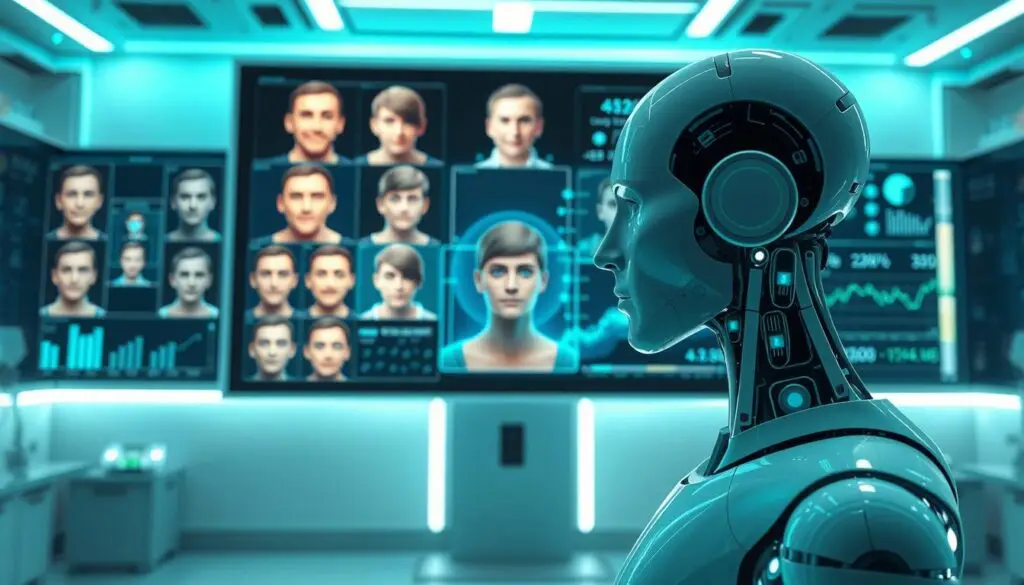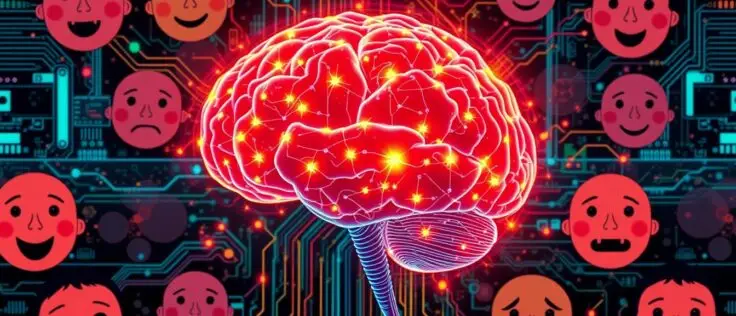In today’s fast-evolving tech world, we’re faced with a big question. Can AI really get and reflect our emotions? The discussion around Emotion Recognition and AI Emotional Insights divides people. Some doubt AI’s ability to understand our complex feelings. Others believe that Human-AI Interaction is reaching new, exciting levels.
Now, more than 77% of companies use AI and machine learning in their work1. The natural language processing market is also growing fast1. This means we’re working hard to bridge the gap between human emotions and AI. It’s not just about automation anymore. It’s about connecting with humans on a deeper level.
So, what does this mean for future empathy helped by technology? Predictive analytics in many fields is now over 90% accurate, thanks to AI1. Affective computing, which helps understand emotional states, could become a huge market of $266.8 million by 20271. Yet, many worry about whether it’s right for machines to mimic human emotions1.
The journey of AI into the world of emotions is not just for study. It’s changing how businesses work, like in retail. This shift shows AI’s power to improve how we shop by making it more personal. It’s about making machines that don’t just work but also connect with us emotionally.
AI is moving towards becoming our partner, not just a tool. Emotional intelligence in AI could soon be a common feature. Mental health apps powered by AI have grown by 32%, showing AI’s role in helping us manage emotions1. User satisfaction has also increased by 25% when AI understands our feelings better1.
Let’s dive deep into this subject. We’ll explore how AI could master the complex world of human emotions. It’s about seeing beyond the data, into the heart of real feelings.
The Emergence of Emotion Recognition in AI Technology
Exploring emotion recognition shows how artificial intelligence (AI) is changing how we interact with machines. The goal to mimic human emotions with AI brings great possibilities and big challenges.
Defining Affective Computing in Modern AI
The idea of Affective Computing started in the mid-90s. It leads in Emotion AI, aiming to find and understand human emotions with cutting-edge AI. This part of AI emotional smarts is about more than just spotting feelings. It makes sure machines react well to our emotions. This builds a stronger Human-AI bond2.
The Evolution from Chess to Emotion Analysis
AI first showed its skills in chess, where it thought strategically but didn’t get emotions. Now, AI is learning to grasp the fine points of our feelings. It uses sensors to look at our faces, voices, and body to get a full picture of our mood. This move to an AI that gets emotions is a big step3.
Examples of Emotion AI in Action
Emotion AI is making waves in many fields. In education, AI helps create caring, responsive places to learn. It notices learners’ emotions, helping to customise teaching to fit what they need2. In healthcare, it aids therapists by keeping track of how patents feel. This gives doctors a deeper view that improves therapy and care plans23.
Unpacking the Complexities of Human Emotional Responses
Neuroscience plays a key role in understanding our emotions. It shows how the amygdala and hippocampus are involved. These brain areas are important for feelings of fear, memories, and excitement. This knowledge helps in creating AI that can analyse how humans feel
The Role of the Amygdala and Hippocampus in Emotions
The amygdala and hippocampus are important for managing our emotions. They help us understand how these emotions affect our behaviour and thinking. This is very useful for making AI that can mimic human feelings.
Neuroscientific Insights into Emotional Processing
Neuroscience offers deep insights into how emotions work in our brains. It’s crucial for making AI that can act like humans emotionally. These discoveries are encouraging for AI development. They could improve how AI understands and reacts to our feelings. For example, AI could offer better support to staff in tough times by understanding emotional coping strategies. Find out how AI can help4.
Debating the Possibility of Empathy in AI Systems
The discussion about adding empathy to AI systems is central in technology talks. Many argue that robots like Pepper by SoftBank Robotics can sense and react to human feelings using artificial emotional intelligence. However, they still miss the true depth of human emotions56. This leads to a debate on if AI’s empathy is real or just an imitation of human characteristics.
The study of empathy in AI combines computer science, psychology, and cognitive science. It aims to make AI systems understand and react to human emotions properly. Research shows AI can recognize feelings through facial expressions and voice tones. Yet, it might only mimic true emotional understanding6. This makes us question the genuine nature of AI’s emotional reactions.
Empathy in AI could greatly benefit areas like healthcare and customer service. AI tools from companies like Affectiva and NeuroLex analyze emotional signals to enhance patient care and customer interactions6. Still, unresolved issues about data privacy and if machines can truly empathize remain.
In closing, adding sentiment analysis and emotional reactions to AI shows progress in technology. But the depth and realness of such empathy are still debated. It’s unclear if AI can genuinely understand and feel, or if it’s just showing programmed responses. This question is at the heart of artificial empathy’s development.
Finding a good work-life balance and personal happiness connects to emotional intelligence. This ties back to the impact of AI on our daily lives.
AI and Emotional Intelligence: Pushing the Boundaries of Affective Computing
The blend of AI with emotional smarts is changing how sectors like healthcare and customer service function. Through affective computing, businesses are getting better at understanding and responding to human feelings.
Emotion AI in Healthcare: Telemedicine and Patient Care
Emotion AI is revolutionising how we interact with patients in healthcare. It’s making treatment more personal and understanding. By looking at the emotions shown on faces and heard in voices, doctors can offer care that really hits the mark. This way, they treat not just the illness but also how the patient feels78.
One of the standout innovations is CompanionMx, with its app for checking mental health via voice. This app can spot changes in someone’s mood or stress, which is a big step forward in caring for mental health8.
AI and Customer Service: Understanding Client Sentiment
In customer service, affective computing is also making waves. Now, AI can figure out how customers feel by analysing faces and the way they talk7. This deeper understanding lets businesses cater better to individual customer needs and likes. Cogito’s emotional AI tool is improving how call centres operate. It senses caller emotions and helps agents adjust their responses, leading to better chats8.
Affective computing keeps advancing, broadening the scope of machines’ emotional intelligence. It’s leading the way for more genuine connections in various fields. As this tech grows, focusing on ethical use and the accuracy of emotional data is key to its success.
Behavioural Analysis: Teaching AI to Read Human Cues
In the fast-growing world of artificial intelligence, Behavioural Analysis is key. It helps create systems that read and react to human emotions well. AI is getting better at picking up complex human signals, like facial expressions and voice tones. This skill improves how AI interacts with people. It also opens new doors in healthcare, customer service, and learning.
Facial Expression Recognition and Its Challenges
Facial Expression Recognition is vital in teaching AI about human feelings. It lets machines figure out what people feel by looking at their faces. But, it’s tough to get this right because people from different places show feelings in various ways. Plus, some emotions are hard to spot. Tools like Convolutional Neural Networks help by studying images to find emotions like joy, sadness, or shock. Emotion-sensing AI needs clear pictures and must work well in all kinds of light to be reliable9.
Vocal Tones and Speech Patterns in AI Algorithms
Studying Vocal Tones in AI adds to understanding facial cues. Together, they give a fuller picture of human emotions. AI systems use Recurrent Neural Networks for this. They can catch the emotional bits in how people talk. This skill is useful in jobs that need a lot of emotional smarts, like helping with mental health or talking to customers. Tools like IBM Watson Tone Analyzer and Microsoft Azure Emotion API look into voice data. They help adjust conversations based on how the customer feels9. These systems need to keep getting better. They should handle different ways of speaking and accents to work well for everyone, everywhere.

AI is heading towards not just spotting but guessing how people will feel. This could change how we connect with each other in schools through digital tools10. Adding emotional AI leads to better experiences online. It also builds stronger, caring interactions. This is a step towards more advanced, emotion-smart AI in the days ahead.
Global Implications of AI's Emotional Cognitive Skills
AI’s Emotional Cognitive Abilities are reaching far beyond labs, impacting numerous sectors globally. They bring change with Affective Computing, moving past old limits. These advances let machines relate better to people and shine in roles needing high emotional intelligence, like healthcare and education. Social Robots, with the skill to comprehend emotions, are set to transform how we interact and support areas like mental health and learning.
Emotion AI leads the charge in AI innovations, fueled by the aim to blend and boost human emotions for better relations between machines and humans11. It focuses on recognizing, creating, and enhancing emotions, showing the deep connection of emotions and thinking in humans and AI11. Research highlights that cognitive AI is about more than making choices. It’s evolving to reason, interact, and give personalized reactions, significantly enriching human-computer exchanges11.
In work settings, AI’s Emotional Cognitive Skills are changing job roles12. Routine tasks get automated, letting AI manage data-focused jobs12. However, jobs needing human empathy and judgement, like in healthcare and education, still depend on people12. This shows AI as a tool to boost performance in various fields, underlining the value of Emotional Cognitive Skills and teamwork between human EQ and AI to get the best results12.
The growth of Affective Computing proves that today’s AI is a global ally. It’s expanding what machines can grasp about human feelings. This growth is crucial for creating Social Robots that are socially skilled, showcasing the power of humans working with machines across different cultures and economies.
Ethical Implications and the Responsibility of AI Developers
The discussion on AI’s ethical side is growing. Developers now face crucial duties that go beyond just coding. These duties include understanding and managing how AI deals with human feelings.
Privacy Concerns with Emotion Data Collection
Navigating Bias and Cultural Sensitivities in AI
Responsible AI creation means dealing with biases and respecting cultures. Emotional intelligence in AI can lower bias in recognizing emotions across different cultures by up to 30%13. This shows why it’s key to build AI that’s not just smart but also ethically aware and sensitive to cultural differences.
AI that adjusts to user’s moods has made customers 25% happier13. This highlights the importance of balancing tech advances with ethical considerations. By improving AI algorithms and using varied data, developers can create fairer AI that respects cultural differences and gains wider acceptance.
As AI spreads across industries like healthcare and customer service, ethical awareness is crucial. Strong privacy rules and a focus on beating bias enable developers to create trustworthy, emotionally intelligent AI systems. These systems can then earn the global trust and confidence of users.
Social Robots: The Integration of AI into Societal Frameworks
Social robots and autonomous agents are becoming a big part of our lives. They’re more than just machines; they can understand and respond to our feelings. This makes them ideal for jobs that need a lot of empathy and understanding.
Autonomous Agents in Public Spaces: Balancing Assistance and Intrusion
This growth in AI usage raises ethical issues, especially about our freedom. There’s worry that robots might make decisions for us without our okay. The discussions on freedom show how these agents might change our social rules16.
Emotional Bonds with AI Companions: Potential Benefits and Risks
But, getting too close to AI friends can risk losing human interaction. We need to ensure that AI respects our dignity and freedom. Philosophers urge us to think critically and ensure our AI interactions reflect our values without being manipulated16.
AI Limitations: The Inevitable Constraints of Machine Learning
Today, many sectors use AI, thanks to machine learning’s ability to sift through huge datasets18. Yet, there’s worry this boom might lead to another AI winter. This fear comes from the gap between what we hope AI can do and what it really does17. Even though AI is great at organising data and improving marketing, it struggles to mimic complex human emotions and thinking1718.
Conclusion: The Future of AI and Its Role in Understanding Human Emotion
The journey of AI began in 1956, thanks to pioneers like John McCarthy and Marvin Minsky. Since then, we’ve reached a point where AI tries to understand emotions19. A company named Affectiva, set up in 2009, has become a leader in this field. It works in automotive AI and advertising, showing that AI can accurately read emotions in people from 87 countries with 90% accuracy19. Today, AI’s ability to analyse feelings is used in many ways. For example, in call centres and telemedicine, it helps us connect and support each other better1920.
However, understanding emotions fully is still a complex challenge. Each culture sees a smile differently, showing both the difficulty and the growth of AI’s emotional understanding21. Google’s Tacotron 2 technology is making synthetic speech sound more like us. But the big question remains: Can AI truly understand our emotions, just like another human19?
Looking ahead, we’re hopeful about AI’s future in grasping human emotion. It could lead to new breakthroughs, like better stress management methods20. By working together, we can build an AI that is sensitive to our emotional needs. This AI would respect our privacy, consent, and cultural differences, making a positive difference in our lives.
FAQ
Can AI truly understand and replicate human emotions?
Artificial Intelligence (AI) has grown better at recognising emotions. It does this through affective computing. But can AI understand and mirror human emotions with real empathy? This is a hot topic for discussion. Some think AI will get better at mimicking emotions. Yet, others say AI can’t match the depth of human feelings.
What is Affective Computing and how does it relate to modern AI?
Affective Computing is part of AI that deals with emotions. It helps AI to see and respond to how humans feel. This makes AI interactions with people smoother and more effective.
How has AI progressed from mastering games like chess to analyzing emotions?
AI has moved from winning at games like chess to understanding human feelings. This jump uses complex algorithms and better learning techniques. It looks at how people talk and act to figure out their emotions.
Can you give examples of Emotion AI currently in use?
Affectiva is an example of Emotion AI. It uses deep learning to understand facial expressions and how people sound. This tech is used in cars for safety, in marketing to learn what customers think, and in healthcare to check on patients’ well-being.
What roles do the amygdala and hippocampus play in our emotional responses?
The amygdala helps us process emotions like fear and joy. It’s key to forming emotional memories. The hippocampus moves info from short-term to long-term memory and helps us navigate spaces. Both are important in how we feel and react to emotions.
How do neuroscientific insights contribute to our understanding of emotional processing in AI?
Learning from neuroscience gives us clues on how the brain processes emotions. It helps in making AI that tries to act in human-like emotional ways. Knowing how the brain works assists in creating AI that recognises and maybe even simulates emotions.
Is it possible for AI to exhibit real empathy?
AI can show actions that seem like empathy by noticing and responding to emotional signals. But does this mean real empathy, which involves deeply sharing and understanding feelings? There’s debate. AI doesn’t have the personal experience or consciousness tied to human empathy.
How is Emotion AI being applied in healthcare?
Emotion AI is used in telemedicine to understand how patients feel to better care for them. It’s also in monitoring systems to spot mood changes. This makes patient care more personalised and effective.
What role does AI have in customer service and sentiment analysis?
In customer service, AI looks at feedback to sense mood, for a more tailored service. For sentiment analysis, it examines the slightest language details in communication. This helps understand customer experiences and wishes better.
What challenges exist for facial expression recognition in AI?
AI struggles to read subtle faces, manage cultural differences, and work with low-quality images. These issues show why we need better algorithms and various training data to improve accuracy.
How does AI interpret vocal tones and speech patterns?
AI uses algorithms to study pitch, tone, speed, and pauses. It combines this with language assessment to gauge emotional content. This shows both possibilities and limits in precisely reading complex human feelings.
What are the global implications of Affective Computing’s expansion?
Affective Computing could change global communication, mental health, and customer service. It may lead to warmer and more efficient global interactions. Yet, it also raises questions on cultural interpretations and how to standardise emotions worldwide.
What privacy concerns arise with emotion data collection by AI?
Collecting emotion data poses big privacy worries. It often deals with private details. Keeping data safe, getting clear consent, and being open are key to earning trust and respecting privacy.
How can AI developers navigate bias and cultural sensitivities?
To deal with bias and cultural issues, AI creators should use diverse data sets. They should also regularly update their algorithms and consider ethics, culture, and social aspects in their work.
What is the role of autonomous agents in public spaces, and how do we balance their assistance with potential intrusion?
Autonomous agents help with info, safety, and finding your way in public areas. The challenge is to ensure they’re helpful without invading privacy. Thoughtful design and deployment are essential.
What are the potential benefits and risks of forming emotional bonds with AI companions?
Forming emotional ties with AI could offer company and support, helping those who feel alone. But, it could lead to less human contact and too much dependence on AI for emotional needs. It’s important to think about these issues as technology grows.
What are the inherent limitations of AI in understanding human emotions?
AI struggles with the complex and personal nature of emotions. This includes not being able to feel emotions itself, difficulties in grasping contexts, and the varied ways people express and experience emotions across cultures.
Source Links
- The Battle Of The Minds: Why AI Will Never Fully Replicate Human Emotions – https://medium.com/@analyticsemergingindia/the-battle-of-the-minds-why-ai-will-never-fully-replicate-human-emotions-db08bdeea61a
- Council Post: The Transformative Potential Of AI In Fostering Emotional Intelligence – https://www.forbes.com/councils/forbestechcouncil/2024/05/16/the-transformative-potential-of-ai-in-fostering-emotional-intelligence/
- Are you 80% angry and 2% sad? Why ‘emotional AI’ is fraught with problems – https://www.theguardian.com/technology/article/2024/jun/23/emotional-artificial-intelligence-chatgpt-4o-hume-algorithmic-bias
- Unpacking the Complexities of Emotional Responses to External Feedback, Internal Feedback Orientation and Emotion Regulation in Higher Education: A Qualitative Exploration – https://www.mdpi.com/2079-8954/11/6/315
- Empathy in Artificial Intelligence – https://www.forbes.com/sites/cognitiveworld/2019/12/17/empathy-in-artificial-intelligence/
- Artificial Empathy: AI and Emotional Intelligence – https://medium.com/@sternalexander/artificial-empathy-ai-and-emotional-intelligence-5923f857e1d1
- The Rise of Emotional AI: How Technology is Revolutionizing Human Interaction – https://www.linkedin.com/pulse/rise-emotional-ai-how-technology-revolutionizing-human-roy-m-tal-srnkf
- What Is Artificial Emotional Intelligence? | Bernard Marr – https://bernardmarr.com/what-is-artificial-emotional-intelligence/
- How AI Is Understanding Human Emotions – https://autogpt.net/how-ai-is-understanding-human-emotions/
- Integrating artificial intelligence to assess emotions in learning environments: a systematic literature review – https://www.ncbi.nlm.nih.gov/pmc/articles/PMC11223560/
- From Emotion AI to Cognitive AI-Scilight – https://www.sciltp.com/journals/ijndi/issue8-paper115.html
- The Impact of AI on Cognitive and Emotional Intelligence in the Workplace – https://www.innovativehumancapital.com/article/the-impact-of-ai-on-cognitive-and-emotional-intelligence-in-the-workplace
- The Role of Emotional Intelligence in Ethical AI Development – https://medium.com/@jamesgondola/the-role-of-emotional-intelligence-in-ethical-ai-development-1f9444881d24
- PDF – https://partnershiponai.org/wp-content/uploads/2021/08/PAI_The-ethics-of-AI-and-emotional-intelligence_073020.pdf
- Robots that Care: Designing Robots to Enhance Human Interaction – Deeper Insights – https://deeperinsights.com/ai-blog/robots-that-care-designing-robots-to-enhance-human-interaction
- Robot Autonomy vs. Human Autonomy: Social Robots, Artificial Intelligence (AI), and the Nature of Autonomy – Minds and Machines – https://link.springer.com/article/10.1007/s11023-021-09579-2
- Why isn’t AI delivering? – https://blogs.lse.ac.uk/businessreview/2022/03/02/why-isnt-ai-delivering/
- Can AI Truly Grasp Human Emotions? Insights with Paul Spiers on Leadership Podcast. – https://www.linkedin.com/pulse/can-ai-truly-grasp-human-emotions-insights-paul-spiers-sodergren-rt6ne
- Can Artificial Intelligence understand emotions? – https://telefonicatech.com/en/blog/can-artificial-intelligence-understand-emotions
- AI’s Emotional Blind Spot: Why Empathy is Key in Mental Health Care – https://therapyhelpers.com/blog/limitations-of-ai-in-understanding-human-emotions/
- The Risks of Using AI to Interpret Human Emotions – https://hbr.org/2019/11/the-risks-of-using-ai-to-interpret-human-emotions






